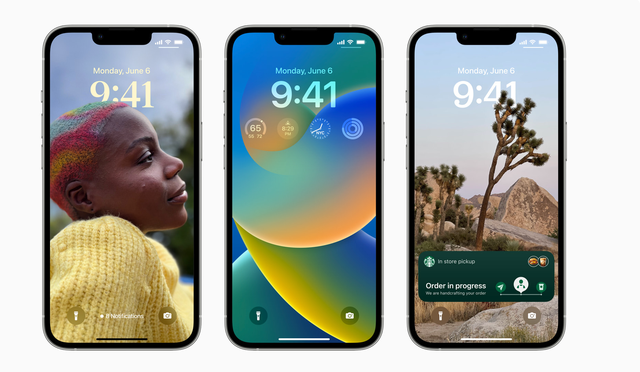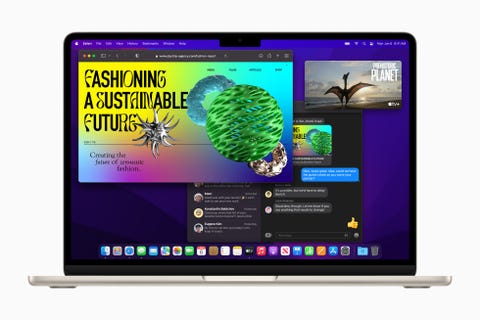At the WWDC 2022 conference, Apple updated us on all the big software improvements coming to Apple devices. At this year's two-hour keynote on June 6th, we got all the latest on iOS 16, the new macOS Ventura, updates in watchOS 9, and new freshly-redesigned MacBook Air to boot.
Here's everything you need to know.
Finally, an all-new MacBook Air that matches the MacBook Pro
Echoing the more squared-off design of the most recent MacBook Pro, the new MacBook Air is powered by Apple’s latest M2 processor (more on that in a second).
It’s basically a baby MacBook Pro.
At 2.7 pounds and a little over 11mm thick, it looks like the MacBook Air will remain the best Mac for most people. The updated display is a 13.6-inch screen with the same rounded corners as the MBP and comes in four colors, including a new deep blue.
An updated 1080p camera should be much better than the old MacBook Air’s relatively awful front-facing camera for video calls, and the same MagSafe tear-away power plug from the MacBook Pro is here, too. (Yup, the new MacBook Air has the same black camera cutout as the MBP and iPhones, for better or worse.)
There’s a new type of charger plug with two USB-C ports, too, which is probably going to be an extra cost for your extra charge.
Oh, speaking of the MacBook Pro, it’s going to get an update to the M2 as well.
Prices for the new MacBook Air start at $1,199 and will be available in July.
Apple Silicon now goes to M2
There’s no question that the M1 chip — designed and built by Apple and inside almost all of its devices in some form at this point — was a big deal, and it’s getting its first major update: a second-generation, 5-nanometer chip family called M2.
We’ll spare you the incremental differences, but expect faster, better, and more efficient computing — as well as more powerful variants like M2 Max and M2 Ultra — to show up in the next updates of the iPad Pro, MacBook Pro, and Mac Studio. Speaking very broadly, it looks the M2 is about 25 percent faster than the M1. That’s great, but don’t expect the same sort of astounding improvement as we saw with the switch from Apple’s previous CPUs to the M1.
New macOS Ventura adds “Stage Manager,” a new focusing mode for a single app, plus Passkeys
WWDC is ultimately about the software, so along with the new MacBooks we have the new macOS: Ventura. But honestly? Its flagship feature is a bit of a headscratcher. The new "Stage Manager" mode throws small versions of your open apps off to one side, then lets you select app groups for different types of work. But macOS already has full-screen app support with easily swipe-able switching using a mouse or trackpad. If there’s anything we’d guess would be forgotten or radically redesigned by next year’s WWDC, it’s Stage Manager.
Meanwhile, Apple Mail gets Undo Send, a la Gmail, and Remind Me, a la also Gmail. Improved search in Apple Mail also shows documents and autocomplete, not just in MacOS but iPadOS and iPhoneOS as well.
“Passkeys” are launching across OSes, using TouchID (and likely other security verification methods) to create a unique password for websites and apps. The upside? No more phishing emails that fool you into sharing your password. The downside? Relying more than ever on Apple to save all your passwords. (Apple has been pretty good about letting you export your saved credentials so far, thankfully.)
The iPhone’s lock screen is getting a big overhaul
iOS 16 is getting a new lick of paint on the lock screen. (The screen you see before you log in with TouchID or FaceID.) New fonts, new color treatments, depth effects for wallpaper and photos, widgets and more. There’s an Apple Watch-style interface that allows for customization beyond the defaults in iOS 15.
It’s very possible these lock screen improvements are being put in place for an always-on iPhone screen in the near future. But for now, you’ll still have to tap or click a button on your iPhone to take a peek.
More detailed and powerful notifications on the lock screen allow developers to split the difference between dedicated widgets and notifications, adding animations and interactions to notifications from apps. And iOS 16 will let you swipe sideways on your lock screens—again, like WatchOS—to quickly change Focus Modes.
You can now edit (and unsend!) messages
You can now edit a message you’ve already sent. (Only on the blue-bubble iOS-to-iOS Messages, of course; Android text messages will probably still get the same annoying double-update text.) You can even unsend a message. They won’t disappear completely from your recipient's Message screen—they’ll see that you made a tweak—but it will be a handy way to tweak all-too-common duck-ups.
"Continuity Camera" lets you use your iPhone as your webcam now
While several third-party apps like Camo have allowed this functionality for a small fee, Apple will now allow you to use your iPhone as a dedicated webcam on your Mac with a feature called “Continuity Camera.” One really cool party trick: by using the wide-angle camera lens on the back of the iPhone, you’ll be able to do a simulated two-camera setup, with one “lens” pointing at you, while the other “lens” will show your physical desktop to show drawings or anything you have sitting near your lap.
CarPlay and the smart Home app are getting more powerful
Apple is embracing Matter, the cross-platform, cross-manufacturer smart home standard. While delayed, it’s promising that Apple feels confident enough in Matter that they’re discussing it at WWDC. (Expect the proper release of the Matter standard later this year.)
With the migration to Matter, Apple has updated the Home app with new categories like climate, lights, and security. A multi-camera view on the front page of the Home app shows live views of your security cameras, and of course the Home app has new lock screen widget integrations, too.
CarPlay, the center-screen UI overlay on most modern cars (or aftermarket stereos), is being updated to allow deeper integration with cars’ displays, including more widgets, the ability to control gauge cluster screens, and have more control over car hardware like air-conditioning or heated seats. As cool as this may be, it’s almost certain that any car you own today won’t be able to get these updates, as automakers rarely go back to existing models to update them to support these sort of improvements.
The new watchOS 9 is small improvements, including Medications tracking
A new lunar watch face shows the phases of the moon and supports Chinese, Islamic, and Hebrew modes as those cultures have more lunar holidays than most.
Apple Watch’s workout mode has three new measurement metrics for runners, the better to optimize your form, as well as custom workouts that let you set up more specific heart rate zone or interval segments. On the same route, you can even measure against your previous workouts to see how you’re improving. (These improvements will be available for some other workout modes—hiking was mentioned—but likely not every single type.)
Medication tracking is now part of Watch OS 9, with a dedicated Medications app that help you track your pills and potions, with notifications to remind you when it’s time to legally boost your T using a supplement you heard about on a podcast. The Medications app will even look out for potential drug interactions and let you know what to look out for.
iPadOS is getting lots of little tweaks, with a major UX improvement
That full multitasking rethink for iPads that was rumored? So that’s Stage Manager. (The same one that was announced for MacOS.) New workspaces and layouts even allows overlapping windows, just like a real computer. Is it life-changing? Unclear as yet, but with the addition of more powerful external monitor support, it’s basically the missing user interface feature to make iPads handle windows like a computer.
The big question? How easy it’ll all be to use, especially without a keyboard.



























